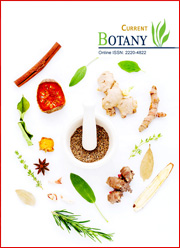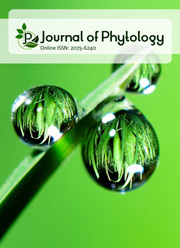GC-MS and FTIR characterization of 1,3,4-oxadiazole from Biophytum sensitivum with potential cardiovascular applications
DOI:
https://doi.org/10.25081/cb.2025.v16.9585Keywords:
Biophytum sensitivum, 1,3,4-oxadiazole, GC-MS, FTIR, Cardiovascular therapeutics, Medicinal plant, Heterocyclic compoundsAbstract
Cardiovascular diseases (CVDs) remain a leading cause of mortality worldwide, with a rising burden in low- and middle-income countries such as India. As concerns grow over the side effects and long-term safety of synthetic drugs, plant-derived bioactive compounds are gaining attention for their therapeutic potential. In this study, the traditional medicinal plant Biophytum sensitivum (L.) DC was investigated for its cardioprotective phytoconstituents. Methanolic (MeOH) extracts of the whole plant were first analyzed using Fourier Transform Infrared Spectroscopy (FTIR), which revealed key functional groups including hydroxyl, ester carbonyl, aromatic, and nitrogenous moieties-features commonly associated with antioxidant and lipid-regulatory activity. Subsequent Gas Chromatography–Mass Spectrometry (GC-MS) profiling identified several secondary metabolites, including two prominent oxadiazole derivatives: 2-p-nitrophenyl-5-isopropyloxy-1,3,4-oxadiazole-5-one and 1,2,5-oxadiazole-3-amine-4-(4-methoxyphenoxy). These heterocyclic compounds are associated with lipid-lowering, calcium channel-modulating, and anti-inflammatory properties, supporting the plant’s therapeutic potential. The findings validate the ethnomedicinal use of B. sensitivum and highlight its promise as a natural source of bioactive molecules for developing safer cardiovascular drugs.
Downloads
References
Cárdenas-Escudero, J., Galan-Madruga, D., & Cáceres, J. O. (2023). Rapid, reliable and easy-to-perform chemometric-less method for rice syrup adulterated honey detection using FTIR-ATR. Talanta, 253, 123961. https://doi.org/10.1016/j.talanta.2022.123961
Eftekhari, A., Khusro, A., Ahmadian, E., Dizaj, S. M., Hasanzadeh, A., & Cucchiarini, M. (2021). Phytochemical and nutra-pharmaceutical attributes of Mentha spp.: A comprehensive review. Arabian Journal of Chemistry, 14(5), 103106. https://doi.org/10.1016/j.arabjc.2021.103106
Faleye, B. C., Bamisaye, F. A., & Fatoki, T. H. (2023). GC-MS characterization and computational assessment of phytochemicals in Heliotropium indicum ethanolic leaves extract. Journal of Complementary and Alternative Medical Research, 22(1), 1-10. https://doi.org/10.9734/jocamr/2023/v22i1447
Gandhi, B., Jhansi, M., Deshpande, S. S., Vinay, T., Misra, S., & Kaki, S. S. (2023). Design, synthesis and biological activity of novel oxadiazole containing monoacylglycerols as potential bioactive lipids. Journal of Molecular Structure, 1284, 135424. https://doi.org/10.1016/j.molstruc.2023.135424
Gao, S., Wang, X., Meng, L. B., Zhang, Y. M., Luo, Y., Gong, T., Liu, D. P., Chen, Z. G., & Li, Y. J. (2022). Recent progress of chronic stress in the development of atherosclerosis. Oxidative Medicine and Cellular Longevity, 2022, 4121173. https://doi.org/10.1155/2022/4121173
Gastaldi, S., Rocca, C., Gianquinto, E., Granieri, M. C., Boscaro, V., Blua, F., Rolando, B., Marini, E., Gallicchio, M., De Bartolo, A., Romeo, N., Mazza, R., Fedele, F., Pagliaro, P., Penna, C., Spyrakis, F., Bertinaria, M., & Angelone, T. (2023). Discovery of a novel 1,3,4-oxadiazol-2-one-based NLRP3 inhibitor as a pharmacological agent to mitigate cardiac and metabolic complications in an experimental model of diet-induced metaflammation. European Journal of Medicinal Chemistry, 257, 115542. https://doi.org/10.1016/j.ejmech.2023.115542
Javaid, A., Khan, I. H., & Ferdosi, M. F. (2021). Bioactive constituents of wild Cannabis sativa roots from Pakistan. Pakistan Journal of Weed Science Research, 27(3), 359. https://doi.org/10.28941/pjwsr.v27i3.984
Luczynski, M., & Kudełko, A. (2022). Synthesis and biological activity of 1,3,4-oxadiazoles used in medicine and agriculture. Applied Sciences, 12(8), 3756. https://doi.org/10.3390/app12083756
Nasrin, S., Islam, M. N., Tayab, M. A., Nasrin, M. S., Siddique, M. A., Emran, T. B., & Reza, A. A. (2022). Chemical profiles and pharmacological insights of Anisomeles indica Kuntze: An experimental chemico-biological interaction. Biomedicine & Pharmacotherapy, 149, 112842. https://doi.org/10.1016/j.biopha.2022.112842
Pallab, K., Tapan, B., Tapas, P., & Ramen, K. (2013). Estimation of total flavonoids content (TPC) and antioxidant activities of methanolic whole plant extract of Biophytum sensitivum Linn. Journal of Drug Delivery and Therapeutics, 3(4), 33-37. https://doi.org/10.22270/jddt.v3i4.546
Rani, J., Kumar, S., Saini, M., Mundlia, J., & Verma, P. K. (2016). Biological potential of pyrimidine derivatives in a new era. Research on Chemical Intermediates, 42, 6777-6804. https://doi.org/10.1007/s11164-016-2525-8
Roopa, D., Bharathi, D. R., & Siva Ganesh, V. (2022). A current study on pharmacology and phytochemistry of Biophytum sensitivum. International Journal of Pharmacognosy and Chemistry, 3(2), 64-71. https://doi.org/10.46796/ijpc.v3i2.319
Rubina, B., Garima, K., Ravi, K., & Manni, D. (2019). Recent developments on pharmacological potential of 1,3,4-oxadiazole scaffold. Indian Journal of Pharmaceutical Education & Research, 53(2S), S1-S16. https://doi.org/10.5530/ijper.53.2s.44
Şahin, B., & İlgün, G. (2022). Risk factors of deaths related to cardiovascular diseases in World Health Organization (WHO) member countries. Health & Social Care in the Community, 30(1), 73-80. https://doi.org/10.1111/hsc.13156
Sharma, A. S., Salahuddin, Mazumder, A., Kumar, R., Datt, V., Shabana, K., Tyagi, S., Shahar Yar, M., & Jawed Ahsan, M. (2023). Recent updates on synthesis, biological activity, and structure-activity relationship of 1,3,4-oxadiazole-quinoline hybrids: A review. Current Organic Synthesis, 20(7), 758-787. https://doi.org/10.2174/1570179420666221004142659
Sivan, A., Singh, C., & Purvia, R. P. (2022). A critical review on Alambusha (Biophytum sensitivum Linn). International Journal of Ayurveda and Pharma Research, 10(Suppl 2), 79-83. https://doi.org/10.47070/ijapr.v10iSuppl2.2552
Solárová, Z., Liskova, A., Samec, M., Kubatka, P., Büsselberg, D., & Solár, P. (2020). Anticancer potential of lichens’ secondary metabolites. Biomolecules, 10(1), 87. https://doi.org/10.3390/biom10010087
Suja, S. R., Bhaskar, S., Bijukumar, B. S., & Prakashkumar, R. (2025). Cardioprotective potential of dietary phytochemicals present in the medicinal foods of Kerala, South India: A review. In Nutraceuticals in cardiac health management (1st ed., pp. 233-264). Boca Raton, Florida: Apple Academic Press.
Turecký, L., Kupčová, V., Urfinová, M., Repiský, M., & Uhlíková, E. (2021). Serum butyrylcholinesterase/HDL-cholesterol ratio and atherogenic index of plasma in patients with fatty liver disease. Vnitrni Lekarstvi, 67(E-2), 4-8. https://doi.org/10.4149/bll_2021_110
Tyagi, T., & Agarwal, M. (2017). Phytochemical screening and GC-MS analysis of bioactive constituents in the ethanolic extract of Pistia stratiotes L. and Eichhornia crassipes (Mart.) Solms. Journal of Pharmacognosy and Phytochemistry, 6(1), 195-206. https://doi.org/10.22159/ijcpr.2017.v9i3.19970
Yang, K., Nong, K., Xu, F., Chen, Y., Yu, J., Lin, L., Hu, X., Wang, Y., Li, T., Dong, J., & Wang, J. (2023). Discovery of novel N-hydroxy-1,2,4-oxadiazole-5-formamides as ASM direct inhibitors for the treatment of atherosclerosis. Journal of Medicinal Chemistry, 66(4), 2681-2698. https://doi.org/10.1021/acs.jmedchem.2c01643
Zhuang, C., Zhang, W., Sheng, C., Zhang, W., Xing, C., & Miao, Z. (2017). Chalcone: A privileged structure in medicinal chemistry. Chemical Reviews, 117(12), 7762-7810. https://doi.org/10.1021/acs.chemrev.7b00020
Published
How to Cite
Issue
Section
Copyright (c) 2025 Jasmine Juliet Richard, Ponnambalam Annapoorani, P. Mariappan

This work is licensed under a Creative Commons Attribution-NonCommercial 3.0 Unported License.



 .
.